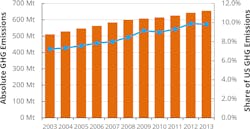Healthcare providers shouldn’t be green about going green
Most of us on this planet might consider 2020 and 2021 as the years when everything changed. Even as we struggled with the pandemic, climate change manifested itself in some of the most dramatic ways imaginable, such as record-setting temperatures, apocalyptic wildfires and unprecedented drought. Every industry is refocusing on reducing environmental harm, and healthcare is no exception.
Of the nearly $1 trillion wasted annually by the U.S. healthcare system, a significant portion is attributable to unnecessary variability and lack of standardization.1 For example, one study showed that the average neurosurgical case wasted nearly $1,000 of unused products due to variability.2 The average hospital could reduce supply expenses by 18% through standardization without sacrificing quality.3 Two very tangible and high-yield opportunities can help operating rooms achieve this: reduction of GHG effect from anesthesia gases and optimized use of reprocessed products (RPs).
Healthcare contributes about 10% of the total greenhouse gases (GHG) emitted in the United States. Hospitals produce about 40% of this, of which about half come from operating rooms, mostly through anesthesia gases, energy use and surgical supplies.4,5 Anesthesia gases may account for between 5% and 65% of the GHGs emitted by operating rooms, depending on the facility.6 The wide range suggests variability that could be standardized to best practice, but most hospitals do not measure how much anesthetic gas is actually used or wasted into the atmosphere. In addition, among the commonly used anesthetic gases, there is as much as a 20-fold variance in their potency as a GHG.7 While this is a controversial topic in the clinical community, no specific anesthesia gas has been shown to result in significant differences in any patient outcomes.8 By changing practice, hospitals can reduce both cost and GHG emissions without affecting quality of care.
Reprocessing of “single-use” surgical devices is a solution that could reduce cost and the amount of solid waste. However, this seemingly straightforward solution is not without challenges. One major challenge is the stigma of the “reprocessed” label that incorrectly implies inferior quality, like “used” or “refurbished” products in other industries, such as cars or personal electronics. In reality, the method of “reprocessing” is often much more than simply cleaning and repackaging a used item; many reprocessed products (RPs) are technically “remanufactured,” utilizing used items as raw materials.
Communicating the quality and reliability of RPs and dispelling myths about the reprocessing process to end users is critical to the success of initiatives to optimize the use of RPs. A 2015 study that compared reprocessed diathermy devices to identical original equipment manufacturer (OEM) controls found fewer defects in the reprocessed devices.9 One explanation for this may be that RPs are individually checked and tested prior to being packaged for sale, whereas mass-produced OEM products are usually checked for quality through random selection.
Optimal use of RPs must also include a thorough analysis of their true “end-to-end” environmental impact compared to OEM products. While use of RPs should decrease the amount of solid waste (and also the demand for OEM device production), factors unique to reprocessing should also be considered, such as the energy required to collect and ship used products, the water and energy used for reprocessing and potential impact of any cleaning chemicals.
The concern for climate change and the role of supply chain cannot be overstated. Global efforts to use resources responsibly and reduce environmental harm must be sustainable and uniformly adopted by all industries. In healthcare, improving the use of anesthesia gases and increasing the adoption of RPs are just two of these opportunities that can be implemented without delay as part of a broad and holistic strategy toward stewardship and sustainability. Supply chain professionals are uniquely positioned to lead these discussions and bring together the right multidisciplinary stakeholders through education and data analytics.
References:
1 Shrank, W. et al. “Waste in the US Health Care System: Estimated Costs and Potential for Savings” JAMA. 2019;322(15):1501-1509.
2 Zygourakis, C., et al. “Operating room waste: disposable supply utilization in neurosurgical procedures” J Neurosurg, Feb 2017
3 https://www.navigant.com/insights/healthcare/2019/study-hospitals-annual-supply-chain-savings
4 Eckelman, M and Sherman, j, Environmental Impacts of the U.S. Health Care System and Effects on Public Health https://journals.plos.org/plosone/article?id=10.1371/journal.pone.0157014
5 MacNeill AJ, et.al. “The impact of surgery on global climate: a carbon footprinting study of operating theatres in three health systems” Lancet Planetary Health 2017; 1: e381-88
6 MacNeill AJ, et.al. “The impact of surgery on global climate: a carbon footprinting study of operating theatres in three health systems” Lancet Planetary Health 2017; 1: e381-88
7 Andersen MP “Assessing the impact on global climate from general anesthetic gases” Anesth Analg. 2012; 114: 1081-1085
8 Chung, J. and Chesebro, B., “Choose the Environment: The Sustainable Practice of Anesthesia Gas Standardization” in Future in Focus: One Clear Vision, The 2020 Vizient Connections Education Summit Report. American College of Medical Quality, Volume 36 Supplement 4S Supplement 1 2021
9 Loftus, T “A Comparison of the Defect Rate Between Original Equipment Manufacturer and Reprocessed Single-Use Bipolar and Ultrasound Diathermy Devices” Journal of Medical Devices, Dec 2015, Vol. 9
About the Author

Jimmy Chung, M.D.
Jimmy Chung, M.D., MBA, FACS, FABQAURP, CMRP, is Chief Medical Officer, Advantus Health Partners, a subsidiary of Bon Secours Mercy Health, Cincinnati. Chung is a member of the Editorial Advisory Board of Healthcare Purchasing News, and next month becomes Chair, Association for Healthcare Resource & Materials Management (AHRMM) Advisory Board.

